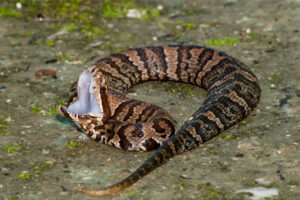OVERVIEW
A trademarked combination of venom preparations from two snakes: water moccasin and cobra
Duo-Venn® is created by combining the novel effects of viper venom (cottonmouth, Agkistrodon piscivorus) and cobra venom (Naja naja) into a novel formula that can be delivered by mouth using a simple oral spray mechanism or as a topical roll-on gel. This novel combination of ingredients was developed in order to provide the best broad spectrum analgesic activity with the highest safety factor. It takes advantage of the cell penetration properties of Cardiotoxins in cobra venom that allows it to be absorbed by mucosal surfaces, even before it reaches the stomach, also with the absorption of Cobrotoxin, a second venom component that can be administered orally. Additionally, Cardiotoxin may also facilitate the absorption of other venom components from Agkistrodon piscivorous such as those components referenced in the US20220362356A1: Composition For Preventing Or Treating Rheumatoid Arthritis, Comprising Snake Venom. See trademark filing here ![]()
Viper venom
 Agkistrodon piscivorus, commonly called the cottonmouth or water moccasin, is a species of pit viper in the subfamily Crotalinae of the family Viperidae. It is one of the world's few semiaquatic vipers and is native to the southeastern United States. As an adult, it is large and capable of delivering a painful and potentially fatal bite.
Agkistrodon piscivorus, commonly called the cottonmouth or water moccasin, is a species of pit viper in the subfamily Crotalinae of the family Viperidae. It is one of the world's few semiaquatic vipers and is native to the southeastern United States. As an adult, it is large and capable of delivering a painful and potentially fatal bite.
Since the 1930s, the venom has been used in conventional (allopathic) medicine to treat a variety of conditions including hemorrhagia {Imerman & Imerman, Thrombocytopenic purpura: Treatment with massive doses of Moccasin snake venom. Calif. & West Med 1938; 48 (5): 335-337}, osteoarthritis {Albee and Maier, A preliminary report on the use of venom in arthritis. Med Rec 1943; 217-221}, herpes simplex {Kelly, Treatment of herpes simplex with moccasin venom. Arch. Dermat. & Syph. 1938; 388: 599—602}, herpes zoster or shingles {Dennie et al., Treatment of herpes zoster with moccasin venom. J. Invert. Derm 1949; 153-155} and even chronic hives {Cohen, Snake venom (Agkistrodon piscivorus) in the treatment of chronic urticaria. Ann Allergy Mar-Apr 1951;9(2):173-83}. The venom was diluted and given by injection and was offered commercially by Sharpe & Dohme (now part of Merck) or Lederle as an FDA approved product for the treatment of idiopathic hemorrhagia. Additionally, it was listed as a homeopathic active before 1900 primarily indicated for use against neuralgia. The venom of Agkistrodon halys has been used as an analgesic to treat severe pain in traditional Chinese recipes suggesting that analgesic proteins may exist in the venom. An analgesic protein named pallanalgesin (MW 16.6 kDa, pI 8.8) was obtained from the venom of Agkistrodon halys and it had significant analgesic activity in different animal pain models of thermal, chemical and mechanical stimulation. It acted on both central and peripheral nerve systems, and it is related to opiate receptors and monoamines rather than acetylcholine receptors. Pallanalgesin could control the levels of neuropeptides in the brain and spinal cord, which contributes to the recovery of nerve injury and pain control {Yong et al. Antinociceptive activity and pathway of the pallanalgesin isolated from venom of Agkistrodon halys (Pallas), Pharmaceutical Biology, 2013;51:8, 987-996}. Agkistrodon rhodostoma venom (Malayan pit viper) is the source of Ancrod in Vipirinex investigated for the treatment of deep vein thrombosis (DVT), central retinal branch vein thrombosis, priapism, pulmonary hypertension of embolic origin, embolism after insertion of prosthetic cardiac valves, rethrombosis after thrombolytic therapy, rethrombosis after vascular surgery, and prevention of DVT. Two antiplatelet drugs have been developed from snake venoms: Tirofiban and Eptifibatide, based on molecules called disintegrins (https://dailymed.nlm.nih.gov/dailymed/search.cfm).
More recently venom from the copperhead snake (Agkistrodon contortix) has been studied for proteins that are active against cancer {Markland et al., A novel snake venom disintegrin that inhibits human ovarian cancer dissemination Haemostasis. 2001 May-Dec;31(3-6):183-91} while in Japan, Agkistrodon Japonicae, was studied as a remedy for fatigue {Tadano et al., Pharmacological studies of nutritive and tonic crude drugs on fatigue in mice. Nihon Yakurigaku Zasshi. 1992 Nov;100(5):423-31}. A snake venom preparation derived from the Chinese water moccasin, Agkistrodon halys pallas, is used in Chinese medicine as a therapeutic agent to treat patients suffering from different forms hepatic disturbances including cirrhosis {Chang et al. Therapeutic Effects and Possible Mechanisms of a Snake Venom Preparation in the Fibrotic Rat Liver Digestive Diseases and Sciences, 2005; 50 (4): 745-752}. Chinese research continues on the 100-pace viper for the treatment of severe acute pancreatitis {Luo et al., A novel recombinant snake venom metalloproteinase from Agkistrodon acutus protects against taurocholate-induced severe acute pancreatitis in rats Biochimie. 2010 Oct.92(10):1354-61}.
Cobra venom
 In the Unani system of medicine-cobra venom has been used as a tonic, aphrodisiac, hepatic stimulant and for revival in collapsed conditions. In modern medicine cobra venom has been used as analgesic, in tabes dorsalis, trigeminal neuralgia, arthritis, epilepsy, angina pectoris and terminal carcinoma. Clinical improvement was reported in locomotor ataxia and parkinsonism {Debnath, Comparative study of some pharmacological actions of crude and Shodhita cobra venom. J. Res Ind Med 1972; 7 (4):54-61}.
In the Unani system of medicine-cobra venom has been used as a tonic, aphrodisiac, hepatic stimulant and for revival in collapsed conditions. In modern medicine cobra venom has been used as analgesic, in tabes dorsalis, trigeminal neuralgia, arthritis, epilepsy, angina pectoris and terminal carcinoma. Clinical improvement was reported in locomotor ataxia and parkinsonism {Debnath, Comparative study of some pharmacological actions of crude and Shodhita cobra venom. J. Res Ind Med 1972; 7 (4):54-61}.
Outside of its use in Indian and Chinese medicine, cobra venom had a similar history of use in Western medicine being first introduced as a homeopathic medicine in the 1870s where it was used for a number ofseveral indications including pain, angina, dysmenia (painful periods) and asthma (Clarke. A Dictionary of Practical Materia Medica. 1900; 2: 523-529). It was reportedly effective against plague, however, thorough study of the texts it seems it was actually aimed at the systemic shock caused by the disease. After the 1900s, interest in its analgesic activity was revived and number clinical studies were undertaken, overall with quite positive outcomes. It was also approved by the FDA sometime around 1940 and again in the 1950s: indicated for rheumatoid arthritis. Data have shown that certain cobra venom proteins can be administered orally {Zhu et al., Antinociceptive and Anti-Inflammatory Effects of Orally Administrated Denatured Naja Naja Atra Venom on Murine Rheumatoid Arthritis Models. Evidence-Based Complementary and Alternative Medicine. 2013; 2013; Article ID 616241, 10 pages} with a very low to negligible potential for toxicity and combinations with other actives to enhance their analgesic activity can be formulated. Two active components in venoms appear to be active by oral administration: cobrotoxin {Chen and Robinson, Effect of cholinergic manipulations on the analgesic response to Cobrotoxin in mice. Life Sci 1990; 47: 1949-1954} and cardiotoxin {Chen et al., Suppression of Inflammation and Arthritis by Orally Administrated Cardiotoxin from Naja naja atra. Evidence-Based Complementary and Altern Med. 2015; 2015: ID 387094, 12 pages}. These laboratory reports lend credence to the clinical reports from Chinese clinicians on the use of orally administered cobra venom to treat inflammation related disease such as diabetic kidney nephropathy (Zhu et al., The clinical treatment of diabetic kidney capsule of Cobra venom. Medicine and Pharmacy of Yunnan, 1997. 18: 460-461), rheumatoid arthritis (Wu and Wu, The treatment of rheumatoid arthritis in 126 cases of venom compound capsule. Journal of Snake, 1999, 11: 30), post operative pain {Xu et al., Randomized, Double-blind, Placebo-controlled, Parallel Multicenter Trial of Cobrotoxin-containing Compound Analgesic in the Treatment of Postoperative Pain. Europain. 2002;2(2): abstract} and pain associated with cancer {Xu et al. Cobrotoxin-containing analgesic compound to treat chronic moderate to severe cancer pain: results from a randomized, double-blind, cross-over study and from an open-label study. Oncol Reports 2006; 16:1077-1084}.
The anti-inflammatory activity of cytotoxin not only appears to help reduce pain in subjects with cancer but may also suppress metastasis {Su JC , Lin KL, Chien CM, Chuang PW, Chang LS, Lin SR. Concomitant inactivation of the epidermal growth factor receptor, phosphatidylinositol 3-kinase/Akt and Janus tyrosine kinase 2/signal transducer and activator of transcription 3 signalling pathways in cardiotoxin III-treated A549 cells. Clin Exp Pharmacol Physiol. 2010 Aug;37(8):833-40; Lin et al., Antimetastatic potential of cardiotoxin III involves inactivation of PI3K/Akt and p38 MAPK signaling pathways in human breast cancer MDA-MB-231 cells. Life Sci. 2012 Jan 2;90(1-2):54-65; Dubovskii and Utkin, Anti-proliferative Activity of Cobra Venom Cytotoxins. Current Topics in Medicinal 638 Chemistry, 2015, 15, 638-648}. In spite of the potent test-tube antitumor activity of cytotoxins, the protein has no real activity in reversing cancer in animals or humans although it may be useful if combined with other anticancer therapies. For example Cardiotoxin, at a subtoxic concentration, enhanced by 6-fold, vinblastine cytotoxicity in OA200 cells {Zheng et al., Human Leukemia K562 Cell Mutant (K562/OA200)S elected for Resistance to Okadaic Acid (Protein Phosphatase Inhibitor) Lacks Protein Kinase C-E, Exhibits Multidrug Resistance Phenotype, and Expresses Drug Pump P-glycoprotein. J. Biol. Chem 1994; 269 (16):12332-12338}.
Cobra venom factor (CVF), a key protein in the snake’s toxin, has long been known to interfere with complement activity in mammals by using up components of the system to the point that it stops working. CVF does this so well that the substance is routinely used in experiments on the role of complement in diseases and to sort out how the system functions (Marcus, Pick Your Poison: Cobra Venom Shows Therapeutic Promise, Scientific American 2008). It is being targeted for use in the treatment of stroke. CVF has been shown to boost the growth of natural bypass blood vessels in animals, suggesting that it can compensate for the loss of arteries caused by vascular occlusive diseases {Götz P et al., Cobra Venom Factor Boosts Arteriogenesis in Mice. Int J Mol Sci. 2022 Jul 30;23(15):8454}.
 King cobra venom (Ophiophagus hannah) has been actively studied as a source of analgesics as has the black mamba (Dendroaspis polylepis). In the early 1990s it was reported that a neurotoxin from OH produced analgesia without causing any neurological or muscular deficits {Pu et al., A novel analgesic toxin (Hannalgesin) from the venom of King cobra (Ophiophagus Hannah). Toxicon 1995; 35 (11); 1425-1431}. It was further shown that such analgesic action was blocked by naloxone suggesting the involvement of the opioid and nitric oxide systems, respectively. In view of the source of this neurotoxin (O. hannah) and its potent analgesic action, it was proposed that this toxin be named hannalgesin. A second protein with analgesic activity, called Ohanin, was later identified {Pung et al., Ohanin, a Novel Protein from King Cobra Venom, Induces Hypolocomotion and Hyperalgesia in Mice. J. Biol Chem. 2005; 280, (13):. 13137–13147}. It was nontoxic up to 10 mg/kg when injected intraperitoneally in mice. Importantly it was recombinantly manufactured and was effectively identical to the natural version, a very important step for large scale production.
King cobra venom (Ophiophagus hannah) has been actively studied as a source of analgesics as has the black mamba (Dendroaspis polylepis). In the early 1990s it was reported that a neurotoxin from OH produced analgesia without causing any neurological or muscular deficits {Pu et al., A novel analgesic toxin (Hannalgesin) from the venom of King cobra (Ophiophagus Hannah). Toxicon 1995; 35 (11); 1425-1431}. It was further shown that such analgesic action was blocked by naloxone suggesting the involvement of the opioid and nitric oxide systems, respectively. In view of the source of this neurotoxin (O. hannah) and its potent analgesic action, it was proposed that this toxin be named hannalgesin. A second protein with analgesic activity, called Ohanin, was later identified {Pung et al., Ohanin, a Novel Protein from King Cobra Venom, Induces Hypolocomotion and Hyperalgesia in Mice. J. Biol Chem. 2005; 280, (13):. 13137–13147}. It was nontoxic up to 10 mg/kg when injected intraperitoneally in mice. Importantly it was recombinantly manufactured and was effectively identical to the natural version, a very important step for large scale production.
Mambas are related to cobras and similar studies were done with mamba venom in 2012. A new class of three-finger peptides from the black mamba was able to abolish pain through inhibition of Acid Sensing Ion Channels expressed either in central or peripheral neurons {Cristofori-Armstrong et al., Mambalgin-3 potentiates human acid-sensing ion channel 1b under mild to moderate acidosis: Implications as an analgesic lead. Proc Natl Acad Sci. 2021;118(8):e2021581118}. These peptides, which were called mambalgins, are not toxic in mice but show a potent analgesic effect upon central and peripheral injection that can be as strong as morphine.
Venom proteins as Cell Penetrating Peptides
Cell penetrating peptides typically have an amino acid composition that either contains a high relative abundance of positively charged amino acids such as lysine or arginine or have sequences that contain an alternating pattern of polar/charged amino acids and non-polar, hydrophobic amino acids. These two types of structures are referred to as polycationic or amphipathic, respectively. The first cell penetrating peptide was discovered independently by two laboratories in 1988, when it was found that the trans-activating transcriptional activator (TAT) from Human Immunodeficiency Virus 1 (HIV-1) could be efficiently taken up from the surrounding media by numerous cell types in culture. Since then, the number of known cell penetrating peptides has expanded considerably and small molecule synthetic analogues with more effective protein transduction properties have been generated.
Recently it was shown that Crotamine, a toxin from the South American Rattlesnake venom (Crotalus durissus terrificus), belongs to the family of cell-penetrating peptides. Moreover, Crotamine was demonstrated to be a marker of centrioles, of cell cycle, and of actively proliferating cells. This toxin at non-toxic concentrations was also capable of binding electrostatically to plasmid DNA forming DNA-peptide complexes whose stabilities overcome the need for chemical conjugation for carrying nucleic acids into cells. Interestingly, Crotamine demonstrates cell specificity and targeted delivery of plasmid DNA into actively proliferating cells both in vitro and in vivo, which distinguishes Crotamine from all other known natural cell penetrating peptides.
Cytotoxins from cobra venom have many properties in common with Crotamine (Table 1).
Table 1. Comparative effects of Crotamine and Cytotoxin
| Activity | CROTAMINE | CYTOTOXIN |
| Target | Heparin Sulphate Sugar, Voltage-gated potassium (KV) channels | Heparin Sulphate Sugar, Interacts with potassium channels |
| Toxic in-vivo | Yes | Yes |
| Mouse ld 50 mg/Kg | 6 or 32 by intraperitoneal inj. | 52 by intramuscular inj. |
| Rat ld 50 mg/kg | n/a | 65 by intramuscular inj. |
| CPP activity in-vitro | Yes, targets nucleus | Yes, targets mitochondria |
| CPP activity in-vivo | Yes | untested |
| Antitumor activity in-vitro | Yes | Yes |
| Antitumor activity in-vivo | Yes, tyrosine kinase inhibitor | not convincing, tyrosine kinase inhibition blocks metastasis |
| Spares normal cells | Yes | Yes |
| DNA binding | Yes | untested |
| Calcium sensitivity | suggested | Yes, in blood cell assay |
| Potentiation of PLA2 | untested | Yes |
| Potentiation of Chemo | untested | Yes |
| Adjuvant activity | untested | Yes, DNA vaccine |
As Cardiotoxin can be administered orally, it motivated the Brazilian researchers test if Crotamine (from the South American rattlesnake)can be orally delivered also. They achieved success and were able to shows its effects against melanoma {Campeiro et al. Oral treatment with a rattlesnake native polypeptide Crotamine efficiently inhibits the tumor growth with no potential toxicity for the host animal and with suggestive positive effects on animal metabolic profile. Amino Acids 2018;50(2):267-278}. The demonstration of proof of concept opens the doors to the exciting potential of using Crotamine to manage cancer and to help deliver other components into tissues {Hayashi et al., Crotamine: a novel cell-penetrating polypeptide nanocarrier with potential anti-cancer and biotechnological applications. Methods Mol Biol. 2012; 906:337-52}, which suggests that Cardiotoxin may have similar transporting activities although this remains to be confirmed.
